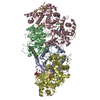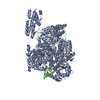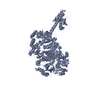[English] 日本語
 Yorodumi
Yorodumi- PDB-6x68: Cryo-EM structure of piggyBac transposase synaptic complex with h... -
+ Open data
Open data
- Basic information
Basic information
| Entry | Database: PDB / ID: 6x68 | ||||||
|---|---|---|---|---|---|---|---|
| Title | Cryo-EM structure of piggyBac transposase synaptic complex with hairpin DNA (SNHP) | ||||||
 Components Components |
| ||||||
 Keywords Keywords | DNA BINDING PROTEIN/DNA / piggyBac / synaptic complex / hairpin DNA / transposase / DNA BINDING PROTEIN-DNA complex | ||||||
| Function / homology | PiggyBac transposable element-derived protein / Transposase IS4 / DNA / DNA (> 10) / Transposase Function and homology information Function and homology information | ||||||
| Biological species |  Trichoplusia ni (cabbage looper) Trichoplusia ni (cabbage looper) | ||||||
| Method | ELECTRON MICROSCOPY / single particle reconstruction / cryo EM / Resolution: 3.66 Å | ||||||
 Authors Authors | Chen, Q. / Hickman, A.B. / Dyda, F. | ||||||
| Funding support |  United States, 1items United States, 1items
| ||||||
 Citation Citation |  Journal: Nat Commun / Year: 2020 Journal: Nat Commun / Year: 2020Title: Structural basis of seamless excision and specific targeting by piggyBac transposase. Authors: Qiujia Chen / Wentian Luo / Ruth Ann Veach / Alison B Hickman / Matthew H Wilson / Fred Dyda /  Abstract: The piggyBac DNA transposon is used widely in genome engineering applications. Unlike other transposons, its excision site can be precisely repaired without leaving footprints and it integrates ...The piggyBac DNA transposon is used widely in genome engineering applications. Unlike other transposons, its excision site can be precisely repaired without leaving footprints and it integrates specifically at TTAA tetranucleotides. We present cryo-EM structures of piggyBac transpososomes: a synaptic complex with hairpin DNA intermediates and a strand transfer complex capturing the integration step. The results show that the excised TTAA hairpin intermediate and the TTAA target adopt essentially identical conformations, providing a mechanistic link connecting the two unique properties of piggyBac. The transposase forms an asymmetric dimer in which the two central domains synapse the ends while two C-terminal domains form a separate dimer that contacts only one transposon end. In the strand transfer structure, target DNA is severely bent and the TTAA target is unpaired. In-cell data suggest that asymmetry promotes synaptic complex formation, and modifying ends with additional transposase binding sites stimulates activity. | ||||||
| History |
|
- Structure visualization
Structure visualization
| Movie |
 Movie viewer Movie viewer |
|---|---|
| Structure viewer | Molecule:  Molmil Molmil Jmol/JSmol Jmol/JSmol |
- Downloads & links
Downloads & links
- Download
Download
| PDBx/mmCIF format |  6x68.cif.gz 6x68.cif.gz | 271.8 KB | Display |  PDBx/mmCIF format PDBx/mmCIF format |
|---|---|---|---|---|
| PDB format |  pdb6x68.ent.gz pdb6x68.ent.gz | 209.6 KB | Display |  PDB format PDB format |
| PDBx/mmJSON format |  6x68.json.gz 6x68.json.gz | Tree view |  PDBx/mmJSON format PDBx/mmJSON format | |
| Others |  Other downloads Other downloads |
-Validation report
| Summary document |  6x68_validation.pdf.gz 6x68_validation.pdf.gz | 870.2 KB | Display |  wwPDB validaton report wwPDB validaton report |
|---|---|---|---|---|
| Full document |  6x68_full_validation.pdf.gz 6x68_full_validation.pdf.gz | 880.6 KB | Display | |
| Data in XML |  6x68_validation.xml.gz 6x68_validation.xml.gz | 32.5 KB | Display | |
| Data in CIF |  6x68_validation.cif.gz 6x68_validation.cif.gz | 50.4 KB | Display | |
| Arichive directory |  https://data.pdbj.org/pub/pdb/validation_reports/x6/6x68 https://data.pdbj.org/pub/pdb/validation_reports/x6/6x68 ftp://data.pdbj.org/pub/pdb/validation_reports/x6/6x68 ftp://data.pdbj.org/pub/pdb/validation_reports/x6/6x68 | HTTPS FTP |
-Related structure data
| Related structure data |  22073MC  6x67C M: map data used to model this data C: citing same article ( |
|---|---|
| Similar structure data |
- Links
Links
- Assembly
Assembly
| Deposited unit | 
|
|---|---|
| 1 |
|
- Components
Components
| #1: Protein | Mass: 68012.969 Da / Num. of mol.: 2 Source method: isolated from a genetically manipulated source Source: (gene. exp.)  Trichoplusia ni (cabbage looper) / Cell line (production host): EXPI293F / Production host: Trichoplusia ni (cabbage looper) / Cell line (production host): EXPI293F / Production host:  Homo sapiens (human) / References: UniProt: Q283G1 Homo sapiens (human) / References: UniProt: Q283G1#2: DNA chain | Mass: 22813.643 Da / Num. of mol.: 2 / Source method: obtained synthetically / Source: (synth.)  Trichoplusia ni (cabbage looper) Trichoplusia ni (cabbage looper)#3: Chemical | ChemComp-CA / #4: Chemical | ChemComp-ZN / Has ligand of interest | N | |
|---|
-Experimental details
-Experiment
| Experiment | Method: ELECTRON MICROSCOPY |
|---|---|
| EM experiment | Aggregation state: PARTICLE / 3D reconstruction method: single particle reconstruction |
- Sample preparation
Sample preparation
| Component | Name: piggyBac transposase complex with hairpin DNA / Type: COMPLEX / Entity ID: #1-#2 / Source: RECOMBINANT | |||||||||||||||||||||||||
|---|---|---|---|---|---|---|---|---|---|---|---|---|---|---|---|---|---|---|---|---|---|---|---|---|---|---|
| Source (natural) | Organism:  Trichoplusia ni (cabbage looper) Trichoplusia ni (cabbage looper) | |||||||||||||||||||||||||
| Source (recombinant) | Organism:  Homo sapiens (human) / Cell: EXPI293F Homo sapiens (human) / Cell: EXPI293F | |||||||||||||||||||||||||
| Buffer solution | pH: 8 | |||||||||||||||||||||||||
| Buffer component |
| |||||||||||||||||||||||||
| Specimen | Conc.: 0.8 mg/ml / Embedding applied: NO / Shadowing applied: NO / Staining applied: NO / Vitrification applied: YES | |||||||||||||||||||||||||
| Specimen support | Grid material: GOLD / Grid mesh size: 300 divisions/in. / Grid type: C-flat-1.2/1.3 | |||||||||||||||||||||||||
| Vitrification | Instrument: FEI VITROBOT MARK IV / Cryogen name: METHANE / Humidity: 100 % / Chamber temperature: 298 K |
- Electron microscopy imaging
Electron microscopy imaging
| Experimental equipment |  Model: Titan Krios / Image courtesy: FEI Company |
|---|---|
| Microscopy | Model: FEI TITAN KRIOS |
| Electron gun | Electron source: TUNGSTEN HAIRPIN / Accelerating voltage: 300 kV / Illumination mode: FLOOD BEAM |
| Electron lens | Mode: BRIGHT FIELD |
| Image recording | Average exposure time: 10 sec. / Electron dose: 73.7 e/Å2 / Detector mode: SUPER-RESOLUTION / Film or detector model: GATAN K2 SUMMIT (4k x 4k) |
| Image scans | Movie frames/image: 50 |
- Processing
Processing
| EM software |
| ||||||||||||||||||||||||||||||||
|---|---|---|---|---|---|---|---|---|---|---|---|---|---|---|---|---|---|---|---|---|---|---|---|---|---|---|---|---|---|---|---|---|---|
| CTF correction | Type: PHASE FLIPPING AND AMPLITUDE CORRECTION | ||||||||||||||||||||||||||||||||
| Particle selection | Num. of particles selected: 2623168 | ||||||||||||||||||||||||||||||||
| Symmetry | Point symmetry: C1 (asymmetric) | ||||||||||||||||||||||||||||||||
| 3D reconstruction | Resolution: 3.66 Å / Resolution method: FSC 0.143 CUT-OFF / Num. of particles: 35960 / Symmetry type: POINT | ||||||||||||||||||||||||||||||||
| Atomic model building | B value: 109 / Protocol: AB INITIO MODEL / Space: REAL / Target criteria: Correlation coefficient |
 Movie
Movie Controller
Controller


 UCSF Chimera
UCSF Chimera







 PDBj
PDBj










































